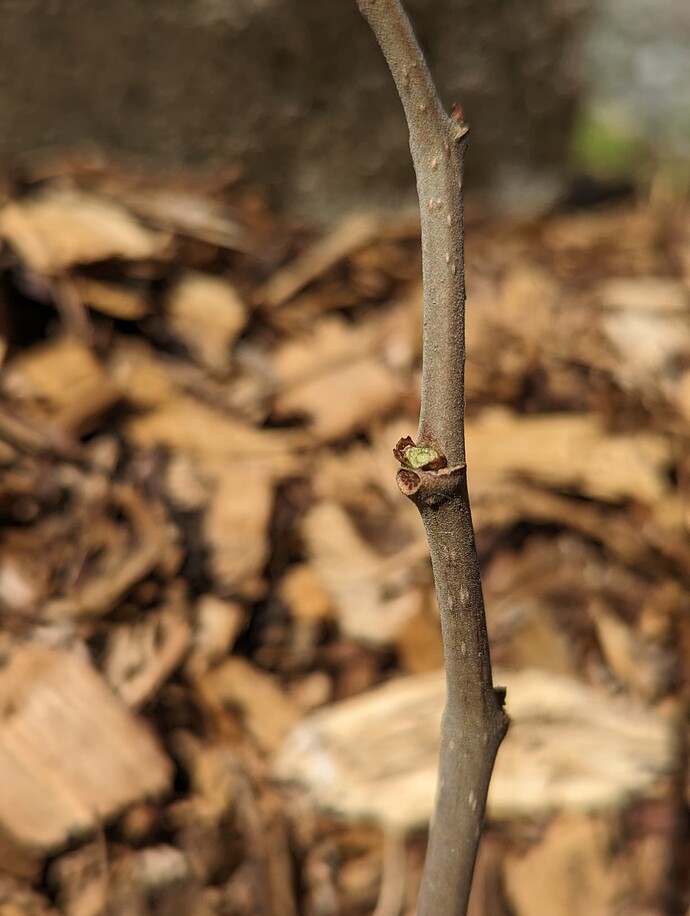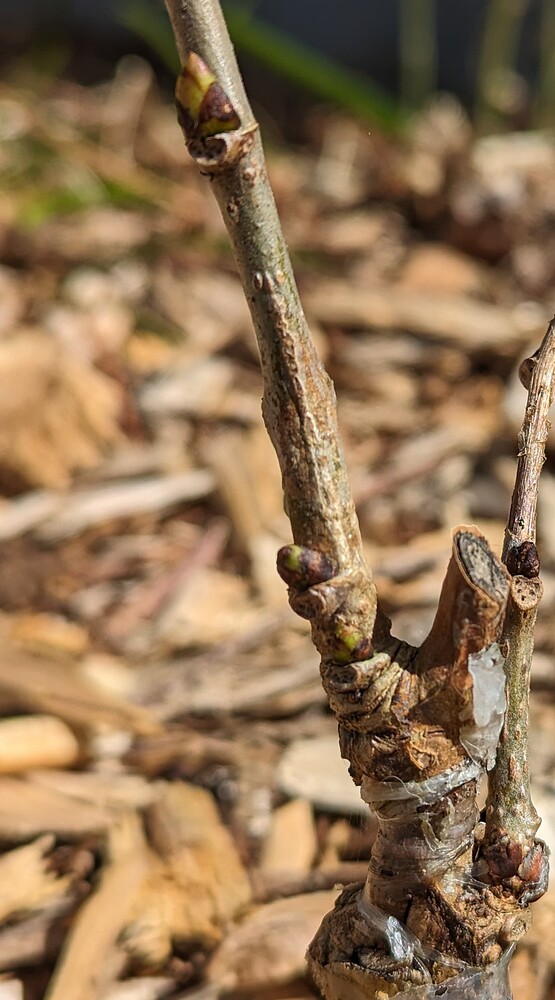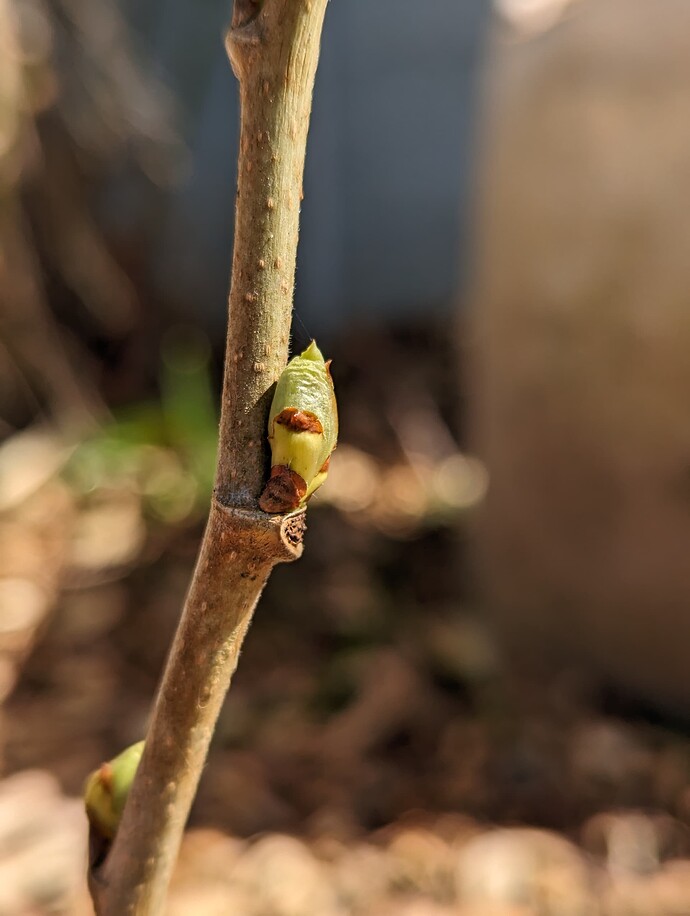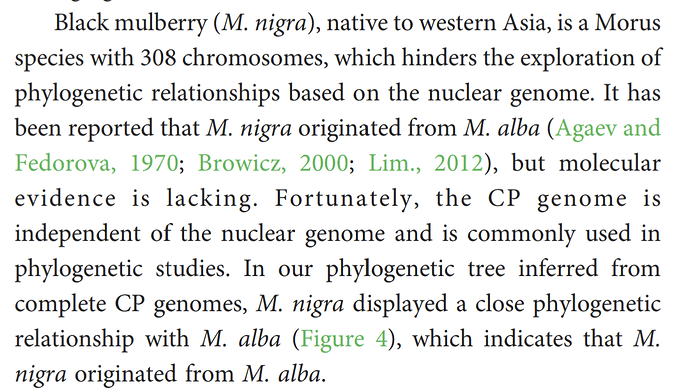Not familiar with Tatarica. Is it a species? Or variety? I know on my Mom’s volunteer mulberries - one specific one takes much better. Maybe its a hybrid rubra?
Three of my rootstocks are tatarica seedlings, and oddly enough two out of three of those had their grafts fail last year. My best rootstocks so far are the rooted cuttings that Marta had sold as Shelli and then realized were mislabeled unknown trees. At least in terms of take rates, none of my nigra grafts on those have failed yet. The T-bud shown above is one of the not-Shelli rooted cuttings.
A Russian landrace of alba. I believe it was treated as a separate species at some point but I think the official way to refer to it now is Morus alba var. tatarica.
I just went to check on that bud graft of Fruitwood’s “Persian” from last summer because I’d noticed it was starting bud swell last week, and something has carefully eaten off every single bud! I hope it will grow new ones but that’s infuriating. Guess it needs a cage. Wonder if it was a rabbit, squirrel, bird, or maybe some other kind of rodent like a rat.
The two grafts of “Kaester” are a bit further behind but starting to show a little green:
By contrast the albas are mostly at least this far along (this is “Galicia”):
That stinks about the nibbling. Maybe cover it with even a ziploc bag for a bit. If you’re lucky itll try again. I have same on my White Babcock Peach graft happen. It looks like its starting new buds at the same spots. One of my plums they dried too much and I thought I’d lost the graft but its doing the same “creating” new buds. So if its got humidity and protection you probably will get it back. Love to see - keep us posted.
I did some single node M. nigra grafts last year and one of them I accidentally broke off the bud. I decided to graft the bud-less node anyway and it actually took and grew very well with two branches forming from the site of the missing bud.
This was a bud graft last year, not a new graft. These buds were on the new growth from last season, not a scion. I’m sure it’ll be fine, I just may need to pinch off rootstock buds to force it to focus on the graft.
Damn frustrating. I don’t think it was rabbit. They don’t seem very precise. They’re more likely to shear the whole stem cleanly like pruners on something that size.
BTW, I have Persian Black if you need another stick. I probably got it from Burnt Ridge or one of the regional nurseries. It grows really slowly, although I barely fertilize. I think most of my trees are nitrogen starved.
I recently came across this interesting 2022 paper that did full-genome comparisons for the chloroplast DNA of a few Morus species, including nigra. The full paper is attached below, but here’s the interesting bit to me:
My question for the people who understand this stuff better is whether this means nigra likely originated as an autopolyploid of alba or whether it’s still equally possible that it originated as a hybrid with another species that just inherited the chloroplast from the alba parent.
My unscientific gut feeling is that nigra is a freak polyploid mutation of alba that occured some time in the distant past, and due to its superior qualities, has been perpetuated since then. Imho
Which raises the question whether nigra is a distinct species or just a unique cultivar of alba…
@swincher
The reality is that phylogenetic trees are biologically unsound and the computer programs used to produce them from assay data are mathematically invalid. No wonder that leading evolutionary geneticists refer to this kind of work as phrenology.
@chriso
M. nigra existed in wild (not feral) populations epochs before cultivation. The same is true of tetraploid M. macroura.
I figured that even if the phylogenetic tree isn’t precisely accurate, the fact they did a full (chloroplast) genome comparison would at least be better than just using genetic markers to compare them, like most studies I’ve seen of this nature.
In other words, I figured this shows that the chloroplast DNA of nigra and alba are at least very closely related, even if using close relatedness to try to recreate evolutionary relationships is questionable.
“Isn’t precisely accurate” is an understatement. Phylogenetic trees are topological fallacies.
The methodology is a statistical generalization. We don’t know enough about the chloroplast contents to make a meaningful comparison.
Frontiers in Plant Science is an overpriced echo chamber.
Alright, well thank you as always for the insight.
I have a Black Beauty that I got a while back. While it’s berries are small an not super plentiful, the late bud break makes fruiting consistent unlike my alba. For someone whode environment is similar to mine, it’s apparent tolerance of winter warm spells comes in handy.
I posted about it before here: Mulberries no work fruit - #278 by CAvocado



